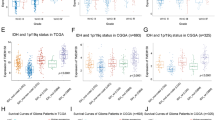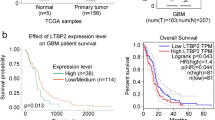Abstract
Glioblastomas (GBMs) are the highest grade of primary brain tumors with astrocytic similarity and are characterized dispersal of tumor cell. Metastasis suppressor 1 (MTSS1) play an important role in cancer metastasis. Recent studies indicating that MTSS1 as a potential tumor suppressor and its reduced expression associated with poor prognosis in many cancer types. However, the relationship with the prognosis of patients and the molecular mechanism of MTSS1 renders a tumor suppressor effect in GBM is unknown. Here, we showed that low MTSS1 gene expression is associated with poor outcomes in patients with GBM. Overexpression of MTSS1 in U-87 MG cells exhibited inhibited glioma cell growth, colony formation, migration and invasion. Mechanistically, we found that high MTSS1 expression in U-87 MG reduced expression of CTTN. These results implicate that the role of MTSS1 suppresses cell migration and invasion by inhibiting expression of CTTN and as a prognosis biomarker in GBM.





Similar content being viewed by others
References
Leder K, Pitter K, Laplant Q, Hambardzumyan D, Ross BD, Chan TA et al (2014) Mathematical modeling of PDGF-driven glioblastoma reveals optimized radiation dosing schedules. Cell 156(3):603–616
Tanaka S, Louis DN, Curry WT, Batchelor TT, Dietrich J (2013) Diagnostic and therapeutic avenues for glioblastoma: no longer a dead end? Nat Rev Clin Oncol 10(1):14–26
Lee YG, Macoska JA, Korenchuk S, Pienta KJ (2002) MIM, a potential metastasis suppressor gene in bladder cancer. Neoplasia 4(4):291–294
Utikal J, Gratchev A, Muller-Molinet I, Oerther S, Kzhyshkowska J, Arens N et al (2006) The expression of metastasis suppressor MIM/MTSS1 is regulated by DNA methylation. Int J Cancer 119(10):2287–2293
Parr C, Jiang WG (2009) Metastasis suppressor 1 (MTSS1) demonstrates prognostic value and anti-metastatic properties in breast cancer. Eur J Cancer 45(9):1673–1683
Huang XY, Huang ZL, Xu YH, Huang XY, Zhou J, Ye SL et al (2010) Effects of MIM-B gene on invasive and metastatic potentials of human hepatocellular carcinoma MHCC97H cells. Zhonghua Gan Zang Bing Za Zhi 18(12):915–919
Ma S, Guan XY, Lee TK, Chan KW (2007) Clinicopathological significance of missing in metastasis B expression in hepatocellular carcinoma. Hum Pathol 38(8):1201–1206
Bompard G, Sharp SJ, Freiss G, Machesky LM (2005) Involvement of Rac in actin cytoskeleton rearrangements induced by MIM-B. J Cell Sci 118(Pt 22):5393–5403
Callahan CA, Ofstad T, Horng L, Wang JK, Zhen HH, Coulombe PA et al (2004) MIM/BEG4, a Sonic hedgehog-responsive gene that potentiates Gli-dependent transcription. Genes Dev 18(22):2724–2729
Wang D, Xu MR, Wang T, Li T, Zhu J (2011) MTSS1 overexpression correlates with poor prognosis in colorectal cancer. J Gastrointest Surg 15(7):1205–1212
Weaver AM (2008) Cortactin in tumor invasiveness. Cancer Lett 265(2):157–166
Lin J, Liu J, Wang Y, Zhu J, Zhou K, Smith N, Zhan X (2005) Differential regulation of cortactin and NWASP- mediated actin polymerization by missing in metastasis (MIM) protein. Oncogene 24(12):2059–2066
Wu H, Reynolds AB, Kanner SB, Vines RR, Parsons JT (1991) Identification and characterization of a novel cytoskeleton-associated pp60src substrate. Mol Cell Biol 11(10):5113–5124
Buday L, Downward J (2007) Roles of cortactin in tumor pathogenesis. Biochim Biophys Acta 1775(2):263–273
Stuible M, Dube N, Tremblay ML (2008) PTP1B regulates cortactin tyrosine phosphorylation by targeting Tyr446. J Biol Chem 283(23):15740–15746
MacGrath SM, Koleske AJ (2012) Cortactin in cell migration and cancer at a glance. J Cell Sci 125(Pt 7):1621–1626
Mezi S, Todi L, Orsi E, Angeloni A, Mancini P (2012) Involvement of the Src-cortactin pathway in migration induced by IGF-1 and EGF in human breast cancer cells. Int J Oncol 41(6):2128–2138
Nakane K, Fujita Y, Terazawa R, Atsumi Y, Kato T, Nozawa Y et al (2012) Inhibition of cortactin and SIRT1 expression attenuates migration and invasion of prostate cancer DU145 cells. Int J Urol 19(1):71–79
Hirakawa H, Shibata K, Nakayama T (2009) Localization of cortactin is associated with colorectal cancer development. Int J Oncol 35(6):1271–1276
Hashimoto A, Hashimoto S, Ando R, Noda K, Ogawa E, Kotani H et al (2011) GEP100-Arf6-AMAP1-cortactin pathway frequently used in cancer invasion is activated by VEGFR2 to promote angiogenesis. PLoS ONE 6(8):e23359
Cen G, Ding HH, Liu B, Wu WD (2014) FBXL5 targets cortactin for ubiquitination-mediated destruction to regulate gastric cancer cell migration. Tumour Biol 35(9):8633–82014
Xu XZ, Garcia MV, Li TY, Khor LY, Gajapathy RS, Spittle C et al (2010) Cytoskeleton alterations in melanoma: aberrant expression of cortactin, an actin-binding adapter protein, correlates with melanocytic tumor progression. Mod Pathol 23(2):187–196
Fan H, Chen L, Zhang F, Quan Y, Su X, Qiu X et al (2012) MTSS1, a novel target of DNA methyltransferase 3B, functions as a tumor suppressor in hepatocellular carcinoma. Oncogene 31(18):2298–2308
Gurtan AM, Sharp PA (2013) The role of miRNAs in regulating gene expression networks. J Mol Biol 425(19):3582–3600
Li J, Lu X (2013) The emerging roles of 3′ untranslated regions in cancer. Cancer Lett 337(1):22–25
Acknowledgments
We thank Reynolds JL for providing the NHA cell. Chenyuan For helpful discussion, and Zhangyuan for technical assistance.
Conflict of interest
The authors declared that they have no conflicts of interest to this work.
Author information
Authors and Affiliations
Corresponding author
Additional information
Qigui Qi has contributed equally to this work.
Rights and permissions
About this article
Cite this article
Zhang, S., Qi, Q. MTSS1 suppresses cell migration and invasion by targeting CTTN in glioblastoma. J Neurooncol 121, 425–431 (2015). https://doi.org/10.1007/s11060-014-1656-2
Received:
Accepted:
Published:
Issue Date:
DOI: https://doi.org/10.1007/s11060-014-1656-2




